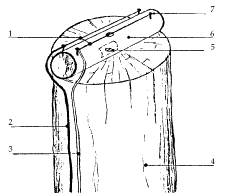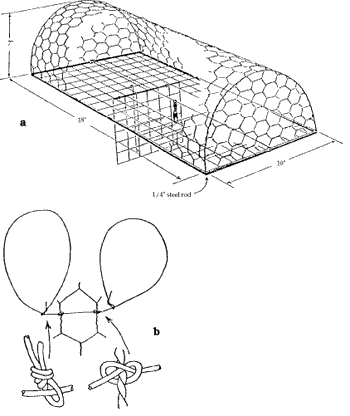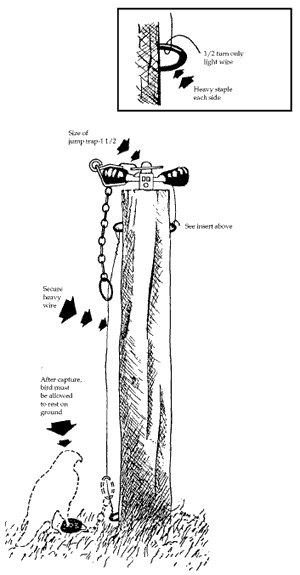|
Hawks and Owls | Hawk and Owl Overview | Hawk and Owl Damage Assessment | Hawk and Owl Damage Management | Hawk and Owl Resources | Hawk and Owl Acknowledgments | ICWDM | Wildlife Species Information |

Contents |
Damage Prevention and Control Methods
Exclusion
The ultimate solution to raptor depredation is prevention. Free-roaming farmyard chickens, ducks, and pigeons attract hawks and owls and are highly susceptible to predation. Many problems can be eliminated by simply housing poultry at night. They can be conditioned to move into coops or houses by feeding or watering them indoors at dusk. If depredation persists, durable fenced enclosures can be constructed by securing poultry wire to a wooden framework and covering the enclosure with poultry wire, nylon netting, or overhead wires (Fig. 2). A double layer of overhead netting separated by a 5-to 6-inch (12- to 15-cm) space may be necessary to keep owls away from penned birds. Large poultry operations rarely have depredation problems because most practice confinement.

Habitat Modification
Habitat modification can make an area less attractive to raptors. Hawks and owls often survey an area from a perch prior to making an attack. Eliminate Perch sites within 100 yards (90 m) of the threatened area by removing large, isolated trees and other perching surfaces. Install utility lines underground and remove telephone poles near poultry-rearing sites. Cap poles with sheet metal cones, Nixalite®, Cat Claws®, or inverted spikes. Improve rabbit escape cover at beagle clubs by constructing brush piles and cutting large trees to increase the density of shrub and ground cover. An abundance of rabbits will often attract raptors. Clubs should release only as many rabbits as are needed for an outing.
Hawks and owls that roost in buildings can be frightened away, or live trapped and removed. Close off all entryways after the birds are out of the building. Common barn owls are endangered in some states and rarely, if ever, cause damage to poultry. Their use of farm buildings, where sanitation problems associated with droppings pose no threat, should be encouraged. Consult your local wildlife agency for information on barn owls in your area.
Frightening
There are many techniques that can be used to scare hawks and owls from an area where they are causing damage. Some are inexpensive and easy to use, while others are not. The effectiveness of frightening devices depends greatly on the bird, area, season, and method of application. Generally, if birds are hungry, they quickly get used to and ignore frightening devices. Frightening devices are usually a means of reducing losses rather than totally eliminating them. Landowners who use them must be willing to tolerate occasional losses.
Increasing human activity in the threatened area will keep most raptors at a distance. The most common and easily implemented frightening device is a shotgun fired into the air in the direction of (not at) the raptor. Scare-crows are effective at repelling raptors when they are moved regularly and used in conjunction with shotgun fire or pyrotechnics.
Pyrotechnics include a variety of exploding or noise-making devices. The most commonly used are shell crackers, which are 12-gauge shotgun shells containing a firecracker that is projected 50 to 100 yards (45 to 90 m) before it explodes. Fire shell crackers in the direction of hawks or owls that are found within the threatened area. An inexpensive open-choke shotgun is recommended. Check the gun barrel after each shot and remove any wadding from the shells that may become lodged in the barrel. Noise, whistle, and bird bombs are also commercially available. They are fired from pistols and are less expensive to use than shell crackers, but their range is limited to 25 to 75 yards (23 to 68 m). Your local fire warden can provide information on local or state permits that are required to possess and use pyrotechnics.
The electric pole shocker is a device developed by R.W. Schmitt of Sheboygan, Wisconsin, to protect game farms and poultry operations (Fig. 3). It has proven very effective in several different settings in Wisconsin. Each unit consists of a ground wire running 1 inch (2.5 cm) from and parallel to a wire that is connected to an electric fence charger. Install electrical shocking units on top of 14-to 16-foot (4- to 5-m) poles and erect the poles around the threatened area at 50- to 100-foot (15- to 30-m) intervals. When a raptor lands on a pole, it receives an electric shock and is repelled from the immediate area. Other perching sites in the area should be removed or made unattractive. Energize the shocking unit only from dusk until dawn for owls and during daylight hours for hawks.

| (1) | uninsulated (exposed) 12-gauge (0.28-cm) copper, ground, and hot wires
(no connection from ground to hot wire) |
| (2) | insulated wire to ground |
| (3) | insulated wire to fence charger |
| (4) | 14-to 16-foot (4- to 5-m) post |
| (5) | mounting screw |
| (6) | 1-inch x 6-inch (2.5- x 15-cm) self-insulating plastic pipe |
| (7) | 3/4-inch (0.2-cm) sheet metal screws with plastic expansion sleeve or tubing between head of screw and plastic pipe |
The electric pole shocker keeps raptors from perching within a threatened area but does not exclude them from nesting in or using a nearby area. Most hawks and owls are highly territorial. A pair that is allowed to remain will aggressively defend the area and usually exclude other hawks and owls. Thus, farmers may actually find it beneficial to coexist with a pair of hawks or owls that have learned to avoid an area protected by pole shockers hardy, easily obtained, and move enough to attract hawks and owls. Other good lures include starlings, rats, and mice. For detailed information on the construction and use of Swedish goshawk traps, see Meng (1971) and Kenward and Marcstrom (1983).
Repellents and Toxicants
No repellents or toxicants are registered or recommended for controlling hawk or owl damage. In years past, raptors were killed by putting out carcasses laced with poison. This practice led to the indiscriminate killing of many nontarget animals. Concerns for human safety also prompted the banning of toxicants for raptor control.
Trapping and Relocating
A landowner must obtain a permit from the US Fish and Wildlife Service and usually the local state wildlife to trap any hawk or owl that is causing damage. Trapping is usually permitted only after other nonlethal techniques have failed. Set traps in the threatened area where they can be checked at least twice a day. If possible, experienced individuals or agency personnel should conduct the trapping and handling of captured birds.

The Swedish goshawk trap is a relatively large, semipermanent trap that can be used to capture all species of hawks and owls (Fig. 4). It consists of two parts: a 3 x 3 x 1-foot (90 x 90 x 30-cm) bait cage made of 1-inch (2.5-cm) mesh welded wire. A trap mechanism consisting of a wooden “A” frame, nylon netting, and a trigger mechanism is mounted on the bait cage. A hawk or owl dropping into the trap will trip the trigger mechanism and be safely trapped inside. Pigeons make very good lures because they are hardy, easily obtained, and move enough to attract hawks and owls. Other good lures include starlings, rats, and mice. For detailed information on the construction and use of Swedish goshawk traps, see Meng (1971) and Kenward and Marcstrom (1983).

The balchatri trap is a relatively small, versatile trap that can be modified to trap specific raptor species (Fig. 5). Live mice are used to lure raptors into landing on the traps. Nylon nooses entangle their feet and hold the birds until they are released. The quonsethut type balchatri was designed for trapping large hawks and owls (Berger and Hamerstrom 1962). The trap is made of 1-inch (2.5-cm) chicken wire, formed into a cage that is 18 inches long, 10 inches wide, and 7 inches high at the middle (46 x 25 x 18 cm). The floor consists of 1-inch (2.5-cm) mesh welded wire with a lure entrance door and steel rod edging for ballast. The top is covered with about 80 nooses of 40-pound (18-kg) test monofilament fishing line (Fig. 5). Pigeons, starlings, house mice, and other small rodents can be used as lures. The trap should be tied to a flexible branch or bush to keep a trapped bird from dragging the trap too far and breaking the nylon nooses.

Spring-net traps are ideal for catching particular hawks or owls that are creating a damage problem (Fig. 6). Square spring nets, hoop nets, and the German “butterfly trap” have all been used successfully. A trap is baited by attaching the partially eaten carcass of a fresh kill or a stuffed bird to the trigger bar. The trap should be camouflaged by covering the frame and folded net with leaves and feathers from the kill. For detailed information on spring-net traps see Kenward and Marcstrom (1983).

Problem hawks and owls can be trapped safely using the sliding padded pole trap because of their tendency to perch prior to making an attack (Fig. 7). Erect 5- to 10-foot (1.5- to 3-m) poles around the threatened area where they can be seen easily and place one padded steel leghold trap (No. 1 1/2) on top of each pole. The jaws must be well padded with surgical tubing or foam rubber and wrapped with electrician’s tape. Run a 12-gauge steel wire through the trap chain ring and staple it to the top and bottom of the post. This allows the trap to slide to the ground where the bird can rest. Some states prohibit the use of pole traps.
- Handling and Transportation
If necessary, landowners can safely handle and transport hawks and owls. The key to successful raptor handling is to control the bird’s feet. The talons can easily grasp a careless hand and inflict a painful injury. There is significantly less chance of injury from the wings and beak. The safest approach, regardless of the type of trap, is to toss an old blanket or coat over both the bird and trap. The darkness will calm most birds and make them less able to defend themselves. Reach in carefully with your bare hands and grasp the bird’s lower legs. Control the feet to avoid getting “footed.” Pull the bird out of the trap so that it is clear of any object on which it could injure itself. Fold the wings down against the body and hold them securely. Check the bird for any signs of external injury, such as cut feet or legs, excessively battered feathers, or scalping (the splitting of the skin over the forehead). If the bird is injured, have a local veterinarian examine it, or in extreme cases, transport it to the nearest raptor rehabilitation center.
Raptors should be restrained before they are transported to reduce the chances of injury to both the bird and handler. The best transport container is a stout, covered cardboard box.
Select a box that is large enough for the bird to stand upright in. Holes should be punched near the bottom of the box to supply fresh air and keep the raptor from struggling toward any cracks of light coming from the top of the box. Carry only one bird per box. Tape an old rag or towel to the floor to provide a good gripping surface to keep the bird from slipping. If a burlap bag must be used to transport the bird, tie the bird’s legs together with a nylon stocking to keep it from footing some-one during transport or release. If possible, ask a local bird bander to attach a leg band. Banding information can be very useful to the research and management of raptors.
Transport the bird as quickly and comfortably as possible. Minimize excess handling, and above all, keep the bird calm and cool. More birds die of overheating during shipment than of any other cause. Transport the bird as far away from the trapping site as possible. Some biologists believe that 20 miles (32 km) is sufficient, but raptors have been known to travel up to 200 miles (320 ) km after release. If a bird is trapped in the fall, help it along its way by transporting it southward.
Shooting
All hawks and owls are protected by federal and state laws. There are cases, however, in which they can create public health and safety hazards or seriously affect a person’s livelihood. Contact your local USDA-APHIS-Wildlife Services office first if you are interested in obtaining a shooting permit. The USFWS and state wildlife agencies may issue shooting permits for problem hawks and owls if nonlethal methods of controlling damage have failed or are impractical and if it is deter-mined that killing the offending birds will alleviate the problem.
Permittees may kill hawks or owls only with a shotgun not larger than 10-gauge, fired from the shoulder and only within the area described by the permit. Permittees may not use blinds or other means of concealment, or decoys or calls that are used to lure birds within gun range. Exceptions to the above must be specifically authorized by USFWS. All hawks or owls that are killed must be turned over to USFWS personnel or their representatives for disposal.
|
Hawks and Owls | Hawk and Owl Overview | Hawk and Owl Damage Assessment | Hawk and Owl Damage Management | Hawk and Owl Resources | Hawk and Owl Acknowledgments | ICWDM | Wildlife Species Information |
